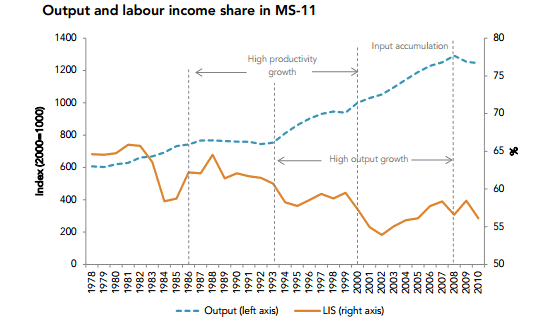
Content supplied by the Productivity Commission
A new working paper released today by the Productivity Commission shows that when productivity goes up, wages follow.
The paper examines the split of income between labour and capital for the measured sector of the New Zealand economy from 1978 to 2010. Movements in the labour income share (LIS) show how changes in labour productivity translate into real-wage growth.
Over the last three decades, the LIS has fallen in most OECD countries as productivity growth has run ahead of growth in real wages. In the last decade or so, there is also evidence of sharper falls in the LIS in some countries, including the United States. This fall in the LIS has been attributed to a number of influences, including new technology, globalisation and reductions in worker bargaining power.
“Even though the LIS has fallen overall in the measured sector of the New Zealand economy, the evidence is that the real wages firms pay their workers increase more rapidly when productivity growth is strong”, says Paul Conway, Director of Economics and Research.
“Over time, growth in real wages paid by firms in the measured sector was strongest during New Zealand’s period of high productivity growth from the mid-1980s to 2000 and much weaker when productivity growth was lower. Higher real-wage increases are also more likely in high-productivity-growth industries.
“In New Zealand, the LIS mostly declined in three short bursts, and then increased on average from the early 2000s, in contrast to further falls in a number of other countries. This could be because earlier reforms increased the flexibility and resilience of the New Zealand economy to adapt to technological shocks. Alternatively, it may also be that factors such as relatively low wages and high capital costs, coupled with small domestic markets and limited international engagement, discourage firms from investing to the same extent in new capital and technology.
“These findings underline the need for New Zealand to have a resilient and flexible economy which can adjust to new technology and help workers adapt to new jobs. The emphasis needs to be on adapting to change, rather than resisting it.”
Note: The measured sector accounts for just over 60% of GDP and includes all industries in the primary and goods-producing sectors, plus some (but not all) service industries.
“Who benefits from productivity growth? The labour income share in New Zealand”, by Paul Conway, Lisa Meehan and Dean Parham, is available from www.productivity.govt.nz

We welcome your comments below. If you are not already registered, please register to comment
Remember we welcome robust, respectful and insightful debate. We don't welcome abusive or defamatory comments and will de-register those repeatedly making such comments. Our current comment policy is here.